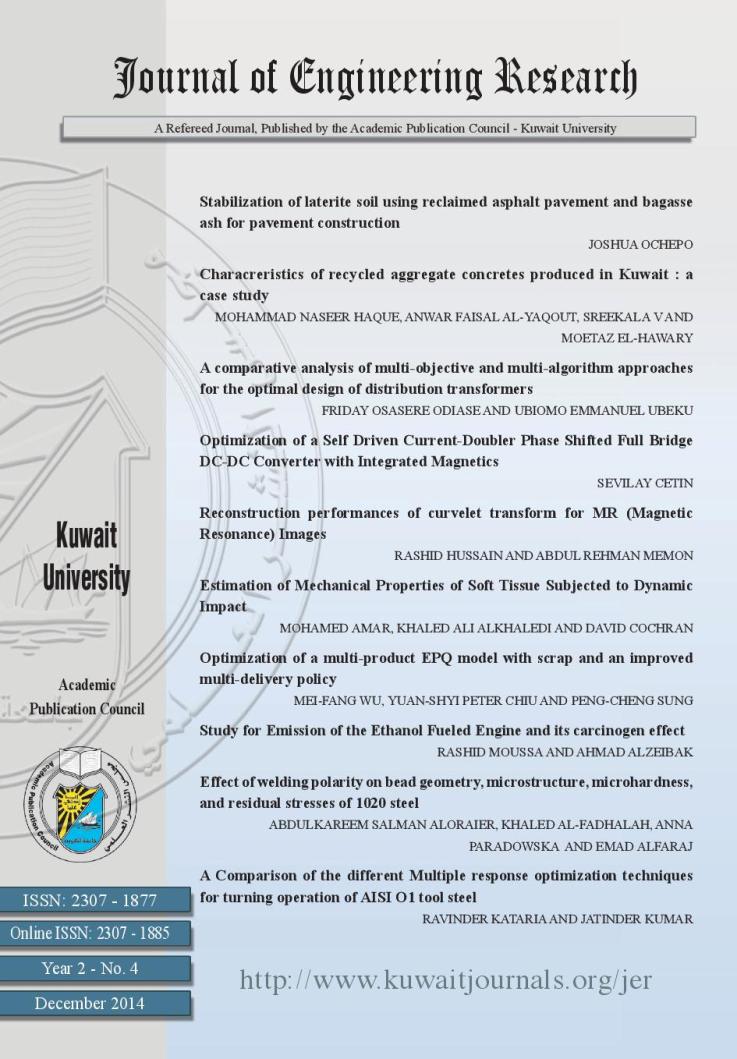Characteristics of recycled aggregate concretes produced in Kuwait : a case study
Abstract
Thirty one concrete mixes made of various combinations of coarse and fine recycledaggregates (produced in Kuwait from demolition waste) were cast and tested.The possibility of producing structural grade concrete using the recycled concreteaggregates (RCA) produced in Kuwait has been investigated in this study. The cubecompressive strength of these concretes was in the range from 26 to 51 MPa. Theconcretes produced exhibited good workability, due to the use of a proprietary superplasticizer.ASTM Type I Portland cement, without any supplementary cementitiousmaterial, in the range of 295 to 509 kg/m3 of concrete has been used. The water –cement ratio of these concretes varied between 0.3 to 0.67. The 28-day experimentallydetermined modulus of elasticity of the concretes ranged from 26 to 39 GPa, which isindicative of good quality concrete. The flexural strength of these concretes was foundto be as high as 6.2 MPa. Strength development of these concretes, up to a period of91 days, was monitored under continuous curing in tap water, in seawater and underair curing. The engineering characteristics of the concretes derived from this studysuggest that the recycled concrete aggregates (RCA) produced from the demolitionwaste in Kuwait are capable of making good quality structural concrete.References
Adjukiewicz, A. & Kliszczewicz, A. 2002. Influence of Recycled Aggregates on Mechanical Properties
of HS / HPC. Cement Concrete Composite 24: 269–279.
ASTM – American Society for Testing and Materials 2006. Significance of Tests and Properties of
Concrete & Concrete Making Materials. ASTM – STP 169 D.
Chidiroglou, I., Goodwin, A. K., Laycock, E. & O’Flaherty, F. 2008. Physical Properties of Demolition
Waste material. Construction Materials 161 (CM3) : 97-103.
Dhir, R. K. 2009. Towards value added Sustainable use of Recycled and Secondary aggregates in Concrete:
Fundamentals, Knowledge, Impact and Practice. Seminar organized by Building and Construction
Authority, Singapore, p.31.
EPIC – Environment Preservation Industrial Company, 2009. Kuwait, Private Communication.
Etxeberria, M., Vazquez, E. & Mari, A. 2006. Microstructure Analysis of Hardened Recycled Aggregate
Concrete. Magazine of Concrete Research 58 (10) : 683-690.
Evangelista, L. & de Brito, J. 2007. Mechanical Behaviour of concrete made with fine recycled Concrete
aggregates. Cement and Concrete Composites 29 (5) : 397-401.
Gomez-Soberon, J. M. V. 2002. Porosity of Recycled Concrete with Substitution of Recycled Concrete
Aggregate : An Experimental Study. Cement and Concrete Research 32 : 1301-1311.
Khatib, J. M. 2004. Properties of Concrete Incorporating fine recycled aggregate. Cement Concrete
Research 35 : 763-769.
Lay, J. 2009. Current Technical Issues for Aggregates. Concrete 43 (6): 14-16.
Limbachiya, M. C., Koulouris, A., Roberts, J. J., & Fried, A. N. 2004. Performance of Recycled
Concrete Aggregates. RILEM International Symposium on Environment-Conscious Materials and
Systems for Sustainable Development, RILEM Publications SARL, France, ISBN- 2-912143-55-1,
pp. 127-136.
Mehta, P. M. & Monteiro, P. J. M. 2006. Concrete, Microstructure, Properties and Materials. McGraw Hill.
Neville, A. M. 1995. Properties of Concrete, Fourth Edition, Longman Group Limited, p.844.
Otsuki, N., Miyasato, S. & Yodsudjai, W. 2003. Influence of Recycled Aggregate on Interfacial
Transition zone, Strength, Chloride Penetration and Carbonation of Concrete. Journal of Materials
in Civil Engineering 1 (5) : 443-451.
Sanchez De Juan, M., & Gutierrez, P.A. 2009. Study on the Influence of Attached Mortar Content on the
Properties of Recycled Concrete Aggregate. Construction and Building Materials 23 : 872-877.






